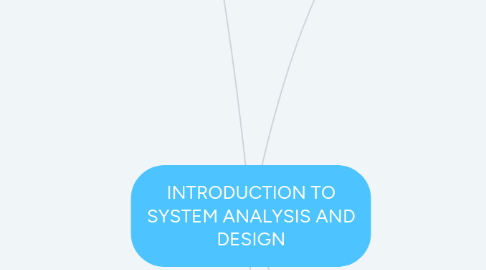
1. Define Information & Information System
1.1. 1)DATA -
1.1.1. Data consists of basic facts that are the system’s raw material
1.2. INFORMATION
1.2.1. Information is data that has been transformed into output that is valuable to users
1.3. Information System (IS)
1.3.1. combines technology, people, and data to provide support for business functions such as order processing, inventory control, human resources, accounting, and many more
2. System Development Method
2.1. Structured Analysis Object Oriented Analysis Agile / Adaptive Method
2.1.1. Structured Analysis -Systems development life cycle (SDLC) --Predictive approach -Uses a set of process models to describe a system graphically -Process-centered technique -Example : Waterfall model -Deliverable or end product - Disadvantage in the built-in structure of the SDLC, because the waterfall model does not emphasize interactivity among the phases -This criticism can be valid if the SDLC phases are followed too rigidly -Adjacent phases usually interact
2.1.2. Object Oriented Analysis -Combines data & processes that act on the data into things called objects -Object is a member of a class -Objects possess properties Methods change an object’s properties -A message requests specific behavior or information from another object -Usually follow a series of analysis and design phases that are similar to the SDLC -Interactive model
2.1.3. Agile/Adaptive Method -Are the newest development - Emphasizes continuous feedback Iterative development - Agile community has published the Agile Manifesto - Example : Spiral model - Agile process determines the end result - Other adaptive variations and related methods exist - Two examples are Scrum and Extreme Programming (XP) - Analysts should understand the pros and cons of any approach before selecting a development method
2.2. System Development Life Cycle Activities
2.2.1. 1) Planning 2) Analyze 3) Design 4) Development 5) Testing 6) Implementation 7) Maintenance
2.3. Waterfall vs Agile
2.3.1. Agile Development 1) Allow interim change in customer development 2) Iterative and Incremental 3) Produces a workable software with every milestone 4) Requires less Cumbersome documentation
2.3.2. Waterfall Model 1) Adhers to the plan developed at the beginning of project 2) Phased and sequential 3) Only a final product is delivered at the end 4) Emphasis on clear and elaborated documentation
2.4. Project Management Activities
2.4.1. 1) Planning 2) Scheduling 3) Monitoring 4) Reporting
2.4.1.1. 1) Planning DEFINITION: Planning is the process of identifying the methods, resources and activities necessary to accomplish the project’s objectives.
2.4.1.2. 2) Scheduling DEFIINITION: Scheduling takes the information from planning and converts it into a Gantt chart.
2.4.1.3. 3) Monitoring DEFINITION: Monitoring is a continuing function that aims primarily to provide the main stakeholders of an ongoing programme or project with early indications of progress or lack thereof in the achievement of programme or project objectives
2.4.1.4. 4) Reporting DEFINITION: Reporting is the systematic and timely provision of essential information used as a basis for decision-making at appropriate management levels.
3. Components of Information Systems
3.1. 1) Hardware 2) Software 3) Data 4) Process 5) People
3.1.1. 1) Hardware: Hardware consists of everything in the physical layer of the information system.
3.1.2. 2) Software: Software refers to the programs that control the hardware and produce the desired information or results. Software consists of system software and application software
3.1.3. (3) Data: Data is the raw material that an information system transforms into useful information.
3.1.4. (4) Processes: Processes describe the tasks and business functions that users, managers, and IT staff members perform to achieve specific results.
3.1.5. (5) People: People who have an interest in an information system are called stakeholders.
4. Various Types Of Information System
4.1. Transaction Processing System (TPS)
4.1.1. Transaction Processing System are operational-level systems at the bottom of the pyramid
4.2. Management Information System (MIS)
4.2.1. The management-level systems that are used by middle managers to help ensure the smooth running of the organization in the short to medium term. The highly structured information provided by these systems allows managers to evaluate an organization's performance by comparing current with previous outputs
4.3. Decision Support System (DSS)
4.3.1. The knowledge based system, used by senior managers, which facilitates the creation of knowledge and allow its integration into the organization. These systems are often used to analyze existing
4.4. Executive Information System (EIS)
4.4.1. Strategic-level information systems. Help executives and senior managers analyze the environment in which the organization operates, to identify long-term trends, and to plan appropriate courses of action. The information in such systems is often weakly structured and comes from both internal and external sources. Executive Information System are designed to be operated directly by executives without the need for intermediaries and easily tailored to the preferences of the individual using them.
